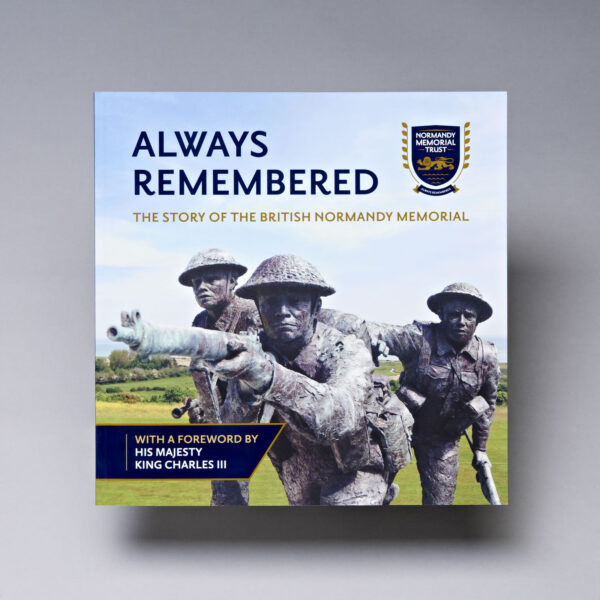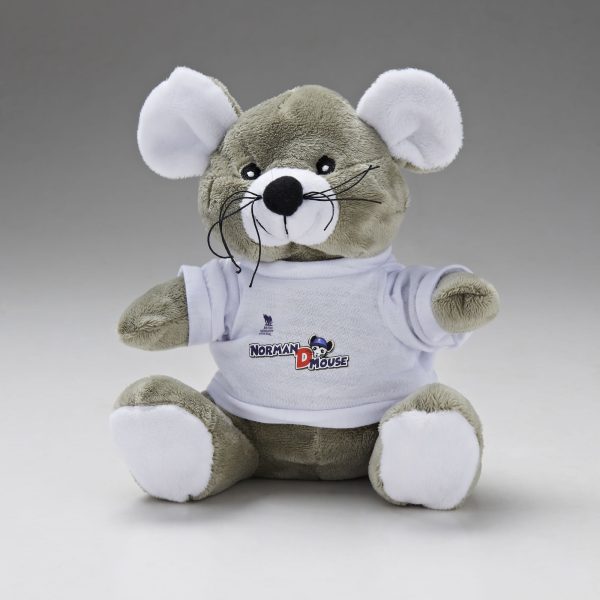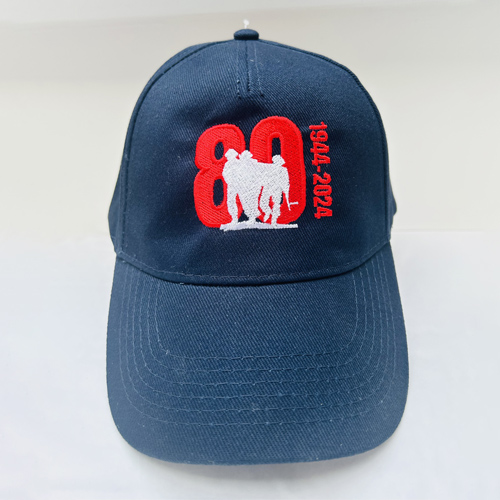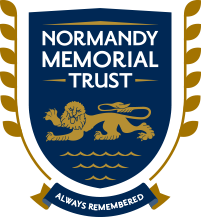
Arthur Herbert 'Tug' Wilson
This story and photos are shared by the Trust with kind permission from Mavis, daughter of Arthur 'Tug' Wilson, and her grandson, Simon.
Remembering Arthur Wilson, 1st Battalion, Royal Norfolk Regiment, Killed in Action, 4 August 1944.
“We drove on a little farther and ahead of us, lying in our path, was a body with a gas cape over it. I climbed out of the carrier to move the body to one side so that we could drive on… I immediately recognised my old friend, Serjeant Herbert ‘Tug’ Wilson. As we picked him up, all I could think of was ’What do I say to his family?’ I knew them all very well”.
Herbert ‘Tug’ Wilson (or very often known by his middle name, Arthur) was the Father of my (Wife’s) Grandmother, Mavis, a man she’d been deprived of ever really knowing, as he died in Normandy when she was nine years old. In conversations between us, memories of her Father are happily recalled from over 80 years earlier, but sadly limited only to occasions he had taken her out when home on a rare period of leave from his career in the Army; a trip to the cinema aged seven to see Sweet Rosie O’Grady the most vivid, and another time going to the Norwich fair. Other knowledge patchy though, being the things Mavis would later be told, or learnt from the treasured book from which I was reading the introductory paragraph above. Sat in her sunny conservatory, and about to visit Normandy for the first time, I wondered if I could bring together more of Arthur’s story…
Arthur lived and grew up in the parish of Old Lakenham, Norwich, Norfolk. Part of a large family so typical of the time, he was the eldest of five boys and two girls. The boys were all thought of as boxers, including Tug, some competing professionally, and with Tug fondly remembered by his daughter boxing on their trip to Norwich Fair.
Arthur would start his own family young, marrying Kathleen Wright from the neighbouring parish of Trowse, on the 6th August 1934. Newly married, their first daughter Mavis, arrived the following year, with the couple having a second, Margaret, a few years later.
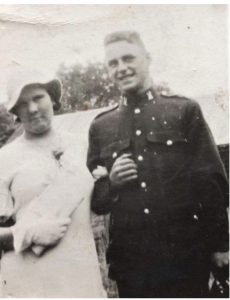
Arthur was a young private, turning 18 in that Summer of 1934, serving with the Royal Norfolk Regiment 1st Battalion with whom he would spend his Army career as a ‘regular’ soldier, leaving his young family behind for long periods to serve in India, where he would continue his boxing when competing for his regiment.
Ten years later, Arthur’s career would end abruptly, by then a valued and high performing Lance Serjeant, on the 4th August 1944 – killed just two days short of his 10th wedding anniversary, and eight days short of his 28th birthday.
Setting sail from Newhaven, most of the Royal Norfolk 1st Battalion arrived in Normandy early on the 6th June, landing on Sword beach, arriving at Queen Red section around 9.50am as part of a second wave. The remaining Norfolks arrived D-day+4.
The early stages of D-Day saw the Royal Norfolks swiftly move inland from Sword beach, clearing the strongpoint codenamed ‘Morris’, before suffering very heavy casualties as they passed closely by the problematic ‘Hillman’ fortification, which so significantly held up the advance towards the original British D-Day objective of Caen. The Norfolks would soon become tied up at Lebisey Wood, lasting into July.
The Royal Norfolk 1st Bn were heavily involved in Operation Bluecoat, the British part of the Allied breakout from Normandy, advancing swiftly during the first week of August 1944, from Le Reculey, to La Chapelle, La Bistiere, and eventually on to Burcey, then Sourdevalle which involved the Victoria Cross winning actions of Sidney Bates.
Arthur died on the 4th August in the small hamlet of La Chappelle au Hants, during heavy fighting encountered on the way South to La Bistiere. It was an area you would describe beautiful, on any other day. A lush green patchwork of tiny fields, with orchards and farmhouses, navigated by sunken lanes and tracks behind the tall banks and dense hedgerows characteristic of the region.
D Company, Arthur’s Rifle Company, were leading the attack, advancing unsupported by artillery until they made contact with the enemy. They suffered badly, with several casualties killed and wounded. In close contact with the enemy, Arthur was killed leading his section over one of those banks into a field.
The exact injury that killed Arthur is unknown, but when moved, his body didn’t have a mark on it, with no sign of blood. A fatal shrapnel wound to his back was perhaps to blame, given the heavy shelling in the area. It would have been a very dangerous spot though for many reasons, with a number of the much feared German Spandau machine guns present and firing overhead, the noise from which was intense and uncanny, sounding like thousands of crickets chirruping. A German armoured car was also present, driving up and down the nearby main Caen to Vire road, machine gunning over the field in which Arthur’s D Company took such heavy casualties. In total four German tanks were recorded in the area, with one ‘hull down’, hidden and protected it proved particularly costly.
The battle of La Bistiere and the bitter fighting it brought would end the next day, with the objective of La Bistiere achieved first thing the next day, found empty of troops and tanks the enemy it seemed had had enough and left under the cover of darkness. Major HR Holden, D Company commanding officer would subsequently be awarded a Military Cross for his leadership through this period.
In the weeks that followed, Major H. R. Holden, would hand write a touching letter to Arthur’s wife in which he painfully remembers the death of his personal friend. Describing Tug as a great friend of everyone in the Battalion, and a very brave and courageous man, the letter also describes him doing very well with D Company and easily the best section commander.
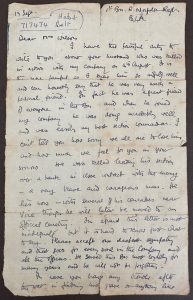
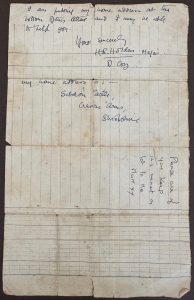
Major Holden wrote:
"I have the painful duty to write to you about your husband who was killed in action with my company on 4th August. It is [...] more painful as I knew him so awfully well and can honestly say that he was very much a personal friend. In fact he was a great friend of everyone in the Bn and when he joined my company he was doing incredibly well and was easily my best section commander. I can't tell you how sorry we all are to lose him and how much we feel for you in your sorrow. He was killed leading his section over a bank in close contact with the enemy - a very brave and courageous man. He lies now, with several of his comrades near Vire though he will later be moved to an official cemetery. I'm afraid this letter is most inadequate but it is hard to know just what to say. Please accept our deepest sympathy and that goes for every soul in the Company and all the officers. He served this Bn most loyally for many years and he will not be forgotten."
The friend that found Tug laying in his path, his body sheltered under a gas cape, was Private Bill Holden, part of an anti-tank platoon tasked with moving up to support the troubled D Company. Bill become a very active veteran, sharing and keeping the events and memories of Normandy alive, including, thankfully, his memories of Arthur. Bill remembered Tug as quiet and likeable, and a gentle and kindly man with a lovely sense of humour, quite different from what he would expect a boxer to be.
Bill had grown up living on the same street as Arthur, and therefore knew him and his family very well. With so much in common they would often travel and spend periods of leave together, despite Arthur’s position as a senior Non-Commissioned Officer and this type of friendship being frowned upon by the Army.
Having initially been laid to rest near Vires, Arthur is permanently buried and remembered at St Charles de Percy War Cemetery. Arthur’s name also appears on the WW2 memorial in Old Lakenham, and now fittingly at the British Normandy Memorial which we visited in March.
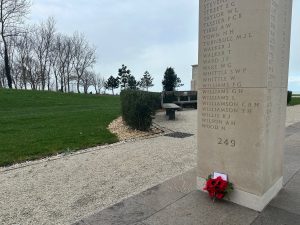

L-R: Column on which Arthur is named and his tribute plaque, British Normandy Memorial
Following her Father’s death, Mavis would be brought up by her Grandparents in a home full of love, but with little contact from Arthur’s side of the family possible. Mavis herself had three children of her own, 5 grandchildren, and so far, two great grandchildren.
British Normandy Memorial - Additional Information
The importance of the letter Major Holden wrote can be seen in a note that Mavis wrote on it: "Please one of you keep. This meant a lot to me M xx"
FALLEN HEROES
ARTHUR HERBERT WILSON
Army • LANCE SERJEANT
Royal Norfolk Regiment
1st BattalionDIED | 04 August 1944
AGE | 27
SERVICE NO. | 5771679
FALLEN HEROES
ARTHUR HERBERT WILSON
Army • LANCE SERJEANT
Royal Norfolk Regiment
1st BattalionDIED | 04 August 1944
AGE | 27
SERVICE NO. | 5771679




